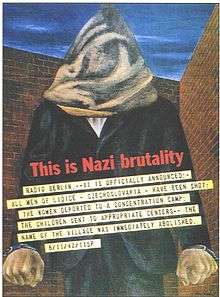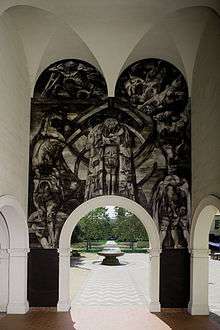Boris Mirski Gallery
| Established | 1944 |
|---|---|
| Dissolved | 1979 |
| Location |
166 Newbury Street Boston, Massachusetts, U.S. |
| Type | Contemporary art gallery |
The Boris Mirski Gallery (1944-1979)[1] was a Boston art gallery owned by Boris Chaim Mirski (1898-1974). The Gallery was known for exhibiting key figures in Boston Expressionism, New York and international modern art styles and non-western art. Mirski himself was known for supporting young, emerging and often Jewish-American artists. The gallery was at the center of Boston's burgeoning modern art scene in the 1940s, as well as instrumental to the birth and development of Boston Expressionism, the most significant branch in American Figurative Expressionism.
History
In the early 1940s, Boris Mirski, a Lithuanian Jewish immigrant, opened a frame shop and small gallery on Charles Street in Boston. In October 1945, he moved his business to a redbrick mansion at 166 Newbury Street, next door to the Guild of Boston Artists. Here he opened a larger gallery and an art school in addition to the frame shop. The gallery made its debut with an exhibition of 53 paintings by the Guatemalan cubist Carlos Mérida.[2][3]

Boston's art scene was notoriously conservative, dominated by the genteel Impressionist painters of the Boston School. Few local collectors were interested in modern art, and only a few galleries deigned to exhibit it.[4] Art historian Charles Giuliano describes the "sea change" that occurred in the late 1940s:
The faculty and focus of the School of the Museum of Fine Arts changed from polite and innocuous, ersatz American Impressionism to gritty and graphic Boston Expressionism. The old guard and its socially acceptable artists showed with the Copley Society of Art or the Guild of Boston Artists. The young Turks, Jews, and immigrants or their sons—like the Lebanese-American Gibran—showed with gallerist Boris Mirski or his former assistants Hyman Swetzoff and Alan Fink of Alpha Gallery.[5]
The Mirski Gallery was an important venue for local artists who did not fit the White Anglo-Saxon Protestant or traditionalist mold, such as Hyman Bloom, Giglio Dante, Kahlil Gibran, and John Woodrow Wilson. Mirksi employed struggling artists in his frame shop and as teachers in his art school. The gallery also hosted exchange shows with Edith Halpert's Downtown Gallery in New York.[6] Alan Fink, who managed the gallery in the 1950s and early 60s, later recalled:
The Mirski Gallery was very conservative by today's standards, but in the '50s it was considered daring. We got protests for showing artists who are now famous and not considered controversial in the least, artists like Hans Hoffmann and Leonard Baskin. And the Boston police once took a picture of a nude out of our window...Mirski and a couple of other galleries were the only ones selling modern art in Boston at the time.[7]
Boston Globe critic Robert Taylor contrasted Mirski's aesthetic with that of two other important Boston gallerists, Margaret Brown and Hyman Swetzoff. Mirski, he said, introduced an "urban, Jewish, introverted and lyrical" visual sensibility to Boston.[8]
Mirski died in Tel Aviv in 1974.[9] The gallery closed in 1979.[1]
Sample Work from Notable Artists
 Rico Lebrun (1900-1964), Genesis at Pomona College, 1960.
Rico Lebrun (1900-1964), Genesis at Pomona College, 1960..jpg) Khalil Gibran (1883-1931), Autorretrato con musa ("Self-Portrait with Muse"), c. 1911.
Khalil Gibran (1883-1931), Autorretrato con musa ("Self-Portrait with Muse"), c. 1911.- Carlos Mérida (1891–1985), Center part of the mural at the Municipal Palace of Chiapa de Corzo, Chiapas, Mexico.
List of Notable Artists
- David Aronson[10]
- Leonard Baskin
- Jason Berger
- Hyman Bloom
- Bernard Chaet[11]
- Esther Geller
- Kahlil Gibran
- Hans Hofmann
- Ellsworth Kelly
- Lawrence Kupferman
- Rico Lebrun
- Jack Levine[7]
- Michael Mazur[12]
- Carlos Mérida[3]
- Carl Gustaf Nelson
- Arthur Polonsky[12]
- Ben Shahn[9]
- Mitchell Siporin[12]
- Barbara Swan
- John Woodrow Wilson
- Karl Zerbe
References
Citations
- 1 2 Archives of American Art.
- ↑ Chaet 1980, p. 29.
- 1 2 TIME 1945.
- ↑ Tonelli 1980, p. 41.
- ↑ Gibran, Giuliano & French 2014, p. 9.
- ↑ McQuaid 2002.
- 1 2 Temin 1982.
- ↑ DeCordova Museum 2002, p. 26.
- 1 2 Taylor 1974.
- ↑ Bookbinder 2005, p. 247.
- ↑ Chaet 1980, p. 25.
- 1 2 3 DeCordova Museum 2002, p. 24.
Bibliography
- Bookbinder, Judith (2005). Boston Modern: Figurative Expressionism as Alternative Modernism. University of New Hampshire Press. ISBN 1-58465-488-0.
- Chaet, Bernard (1980). "The Boston Expressionist School: A Painter's Recollection of the Forties". Archives of American Art Journal. 20 (1): 25–30. JSTOR 1557495.
- DeCordova Museum (2002). Painting in Boston, 1950-2000. University of Massachusetts Press. ISBN 9781558493643.
- Gibran, Jean; Giuliano, Charles; French, Katherine (2014). Love Made Visible: Scenes from a Mostly Happy Marriage. Interlink. ISBN 9781566569781.
- McQuaid, Cate (September 18, 2002). "Despite Gaps, Exhibit Shows Boston's Vigor in the 40s". The Boston Globe. (Subscription required (help)).
- Taylor, Robert (July 30, 1974). "Boris Mirski, Dean of Newbury St. Art Dealers, Dies". The Boston Globe. (Subscription required (help)).
- Temin, Christine (May 6, 1982). "The Art of Running a Boston Gallery". The Boston Globe. (Subscription required (help)).
- Tonelli, Edith (1980). "The Avant-Garde in Boston: The Experiment of the WPA Federal Art Project". Archives of American Art Journal. 20 (1): 18–24. JSTOR 1557494.
- "Boris Mirski gallery records, 1944-1979". Archives of American Art. Retrieved December 3, 2017.
- "Art: Boston Surprise". TIME. October 15, 1945.
Further reading
- Mayer, Stephanie (2002). "A Painter's Revolution: Building a Community for Modern Art in Boston". The Visionary Decade: New Voices in Art in 1940s Boston. Boston University Art Gallery. ISBN 9781881450191.
External links
- Boris Mirski Gallery in libraries (WorldCat catalog)